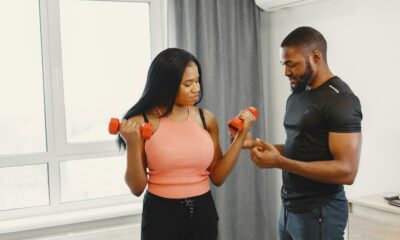Features
Drop the Weight with EJ: Hungry After That Work Out? Here’s What To Do!
 It’s normal for you to feel hungrier on the days you exercise for the simple reason that you exercised. Exercise burns calories and your body getting hungrier on your exercise days is because it’s looking to you to replenish that energy. Now let’s dive into why.
It’s normal for you to feel hungrier on the days you exercise for the simple reason that you exercised. Exercise burns calories and your body getting hungrier on your exercise days is because it’s looking to you to replenish that energy. Now let’s dive into why.
Your body likes to be in balance. In fact one of its sole purposes is to keep you alive by keeping you balanced. This is why you feel bloated after a day of eating a lot of salt and why you pee a lot when you drink a lot of water ~ it’s your body at work trying to maintain your salt balance. It works the same way when you start to play with your calorie balance.
Exercise is one way of playing with your calorie balance to help you lose weight. So when you exercise more than normal, your body is going to demand more calories by getting hungrier. And when you eat less to lose weight, your body would do the same. That’s why following the simple advice to eat less and exercise more to lose weight can leave you feeling hungry all the time, which can make it difficult to stay the course.
I’ll be the first to admit that the simplistic eat less and exercise more advice sounds easy to follow, but is difficult to execute. And that’s because there’s some nuance to it. This is the nuance that I missed in the past and this led me and my clients to days of what I call a bone-deep hunger. Thankfully, there is another path and that’s what I’ll be sharing with you next to help you avoid the post workout munchies.
Eat More High Quality Foods
To lose weight, you’ll still need to eat less food, but the goal would be to less processed, low-quality calories and eat more high-quality food. By quality, I’m not referring to how much it costs, rather, I’m talking about what’s in it.
High-quality foods include:
- non-starchy Vegetables & Fruits (V),
- Animal & Plant Protein (A),
- Fats (F),
- and starchy vegetables & whole grains (s).
I abbreviate this list to create an acronym to remember what should be in a healthy eating pattern that supports weight loss and I call it VAFs.
A diet made up of mostly VAFs is filled with nutrients in a lower calorie package that can help you lose weight without calorie counting or deprivation.
The reason why food quality matters is what happens when you decide to become more physically active. Your metabolism will go up, which is the effect that you’re after. But your increased metabolism will mean that you’re going to want to eat more, and this is where VAFs foods can help.
Because most of the foods on the VAFs list are unprocessed, your body has to work a little harder and spend more time digesting it. This puts your new revved up metabolism to work in a different way because it has more to do. If you’re curious of what foods qualify as VAFs, then I have a gift for you. I wrote a cheat sheet called The Ultimate Cheat Sheet of Healthy Foods that Support Weight Loss and you can click here to grab your copy.
Change How You Workout
To lose weight you also need to exercise more than you do now, but this doesn’t mean that you have to exercise for two hours a day to get results. It’s an easy trap to fall into and it’s one that I happily fell for when I had the time. There was a time I worked out 2 hours a day and still struggled to maintain my dream body because I was hungry all the time and found myself depleted and caving to my cravings. These days I workout 2 hours or less per week and I’m leaner and healthier than I was then. And that was almost 10 years ago!
So what’s the difference? The difference is that I’m not exercising to burn calories and I’m not exercising to make up for an unhealthy diet. Like I said earlier, when you burn more calories your body will ask for you to replace them by getting hungrier more often.
Instead of exercising to burn calories, exercise to maintain your current muscle mass and to build it if possible. The easiest way to do this is to workout just enough that your body doesn’t start digging into your muscle stores.
You want to maintain your muscle because it burns more calories at rest than fat does ~ at least three times more. So if you preserve muscle while losing fat, you’ll turn your body into a calorie burning machine even when you’re not exercising.
High Intensity Circuit workouts that are 20 – 30 minutes long can help you preserve and build muscle, while boosting your health and using some of the stored fat that you’re trying lose. And when you pair this type of exercise with a diet that’s packed with healthy, high-quality foods like VAFs, you’ll be setting yourself up for success.
Take Action
Now that you know that feeling hungrier than normal on the days you workout is normal, and now that you know that the quality of the nutrients that you eat before and after your workouts can influence this – I want you to grab your copy of the Ultimate Cheat Sheet of Healthy Foods that Support Weight Loss.
This Cheat Sheet will help you make sure that you know what healthy foods you have available to you so you can plan in advance to make sure you choose a healthy, high quality option to keep the post-workout munchies at bay.
Photo Credit: Dreamstime





















